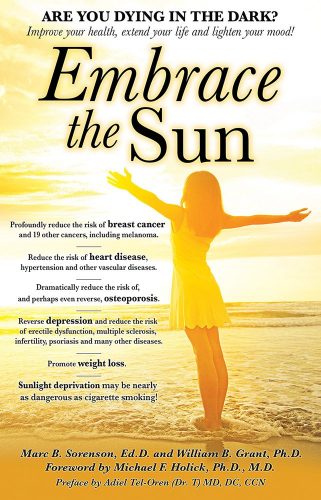Sepsis and septicemia, major killers that associate with sun deprivation. By Marc Sorenson, EdD

Sepsis facts:
Sepsis is an infection of tissues by bacteria, and septicemia is a form of sepsis that infects the blood. Septicemia is a severe and often deadly blood infection. Noxious bacteria attack tissue or blood, and when they die or when their cell walls rupture, they release poison (endotoxin). So, these dying organisms may do more harm than the bacterial attack itself. In addition, the disease accounts for 500,000 emergency-room hospital visits per year in the USA. And, it is followed by a typical stay of 6 to 9 days.[1] As a result, it is one of the worst medical conditions. And, it often results in multiple organ failure and death. There are about 750,000 cases per year, and about 3% of all hospital admissions result in a case of sepsis. Read more.
Sepsis and hospitals
Hospitals are hotbeds of antibiotic-resistant “superbugs” and other infectious agents. In cases of severe sepsis, antibiotics have not improved survival. In fact, antibiotics may produce molecules that exacerbate sepsis.[2] Therefore, the health system must urgently find and implement non-antibiotic solutions to this crisis.
Also, it should be remembered that sunlight is said to be the best disinfectant.[3] The annual cost of care for sepsis is about $17 billion. And, in the case of severe sepsis, antibiotics have not improved survival. In fact, it is especially relevant that antibiotics may produce molecules that exacerbate it.[4] Sepsis is one of the top-ten causes of death and the second leading cause of hospital-associated deaths. So only coronary intensive care units end up having more deaths. In North America, sepsis and its related disorders kill more hospitalized people than heart attacks, colon cancer, breast cancer or AIDS.
Dr. William B. Grant’s research with sepsis and septicemia.
Dr. William Grant hypothesized that vitamin D deficiency, due to inadequate sun exposure, is a risk factor. That is true for both sepsis and septicemia.[5] He points out that septicemia incidence is also highest in winter and lowest in the autumn. Another point is that rates are highest in the Northeast (low sunlight) and lowest in the Southwest (high sunlight).[6] Therefore, all of this leads to the idea that sun deficiency is a major cause this disorder.

Consequently, sun deficiency could play a strong causal role in the disease, since deficiency inhibits the production of cathelicidins. Cathelicidins are antimicrobial peptides which facilitate the destruction of pathogenic germs’ cell walls, leading to their death. In addition, these peptides also help inactivate the endotoxins released as a result of that destruction.[7], [8], [9]
Stay well and thereby avoid hospitals (and sepsis).
Finally, it would be best to avoid hospitals and their superbugs. The formula? Obtain some regular, non-screened, non-burning sunlight around noon when available. Happy sunning! And be sure to read my new book, Embrace the Sun.

[1] http://www.summitmedicalgroup.com/library/adult_care/ac-sepsis_dx/
[2] Mookherjee N, Rehaume LM, Hancock RE. Cathelicidins and functional analogues as antisepsis molecules. Expert Opinions on Therapeutic Targets 2007;11:993-1004
[3]http://sunlightinstitute.org/tag/sepsis/.
[4] Mookherjee N, Rehaume LM, Hancock RE. Cathelicidins and functional analogues as antisepsis molecules. Expert Opinions on Therapeutic Targets 2007;11:993-1004.
[5] Grant, WB. Solar ultraviolet-B irradiance and vitamin D reduce the risk of septicemia. Dermatoendocrinol 2009;1:37-42.
[6] Danai PA, Sinha S, Moss M, Haber MJ, Martin GS. Seasonal variation in the epidemiology of sepsis. Crit Care Med. 2007;35:410–15.
[7] Giacometti A, Cirioni O, Ghiselli R, Mocchegiani F, D’Amato G, Circo R, Orlando F, Skerlavaj B, Silvestri C, Saba V, Zanetti M, Scalise G. Cathelicidin peptide sheep myeloid antimicrobial peptide-29 prevents endotoxin-induced mortality in rat models of septic shock. Am J Respir Crit Care Med 2004;169:187-94.
[8] Giacometti A, Cirioni O, Ghiselli R, Bergnach C, Orlando F, D’Amato G, Mocchegiani F, Silvestri C, Del Prete MS, Skerlavaj B, Saba V, Zanetti M, Scalise G. The antimicrobial peptide BMAP-28 reduces lethality in mouse models of staphylococcal sepsis. Crit Care Med. 2004;32:2485–90.
[9] Cirioni O, Giacometti A, Ghiselli R, Bergnach C, Orlando F, Silvestri C, Mocchegiani F, Licci A, Skerlavaj B, Rocchi M, Saba V, Zanetti M, Scalise G. LL-37 protects rats against lethal sepsis caused by gram-negative bacteria. Antimicrob Agents Chemother. 2006;50:1672–9
By Marc Sorenson, EdD, Sunlight Institute…
In the previous blog, we noted that sun exposure was associated with a reduced risk of the deadly bacterial infection called sepsis. In reality, UV therapy was used to treat many kinds of infections decades ago, when sun exposure was widely known as a bactericide.
Dr. Zane Kime, in his book, Sunlight could Save Your Life, reviewed the results of research conducted between 1886 and 1909 and showed that the following bacteria were killed by ultraviolet light: anthrax, plague, streptococci, tubercle bacillus, cholera, staphylococcus, colon bacillus and dysentery bacillus.[1] Sun was virtually forgotten with the advent of antibiotic drugs, but now the interest has returned.
While watching a newscast, I noticed the news ticker along the bottom of the screen announcing, “Sunshine is the most effective anti-infection therapy.” But is this really news? Dr. Kime cites several early studies on sun and infectious diseases that were performed about the same time as the advent of antibiotics. Reports in the scientific literature in the 1940s showed that sun killed infectious bacteria or viruses. Kime states …“a number of patients, having such various infections and diseases as blood poisoning [septicemia], childbirth infections, peritonitis, viral pneumonia, mumps, and bronchial asthma were treated with ultraviolet light therapy to their blood.”[2] [3] [4] [5] [6] [7] [8] [9] [10] [11] They were, in fact, treated very successfully.
Dr. Kime also cited research showing that UV therapy killed the flu virus outside the body[12] and destroyed cancer-producing viruses.[13] He reported good results in his own practice in treating fungal infections with sun therapy.
The ancients knew of the marvelous healing effects of sun exposure, and Dr. Kime knew even more in 1980 as he reviewed the literature. We need more people who are willing to promulgate the truth about our kindly friend, the sun.
[1] Kime, Z. Sunlight Could Save Your Life. World Health Publications, Penryn, CA 1980 pp 180-81.
[2] Miley, G. The Knott technic of ultraviolet blood irradiation in acute pyogenic infections. New York J Med 1942;42:38.
[3] Miley, G. The Knott technic of ultraviolet blood irradiation in acute pyogenic infections. New York J Med 1942;42:38.
[4] Rebbeck, E. Ultraviolet irradiation of auto-transfused blood in the treatment of puerperal sepsis. Amer J Surg 1941;54:691
[5] Rebbeck, E. Ultraviolet irradiation of autotransfused blood in the treatment of postabortal sepsis. Amer J Surg 1942;55:476.
[6] Rebbeck, E. Ultraviolet irradiation of the blood in the treatment of escherichia coli septicemia. Arch Phys Ther 1943;24:158.
[7] Rebbeck, E. The Knott technic of ultraviolet blood irradiation as a control of infection in peritonitis. Amer J Gastroenterol 1943;10:1-26
[8] Hancock, V. Irradiated blood transfusions in the treatment of infections. Northwest Med 1934;33:200.
[9] Barrett, H. Five years experience with hemo-irradiation according to the Knott technic. Am J Surg 1943;61:42
[10] Barrett, H. The irradiation of auto-transfused blood by ultraviolet spectral energy: results of therapy in 110 cases. Med Clin N Amer 1940;24:723
[11] Miley, G. The present status of ultraviolet blood irradiation. Arch Phys Ther 1944;25:357.
[12] Hollaender, A. The inactivating effect of monochromatic ultraviolet radiation on influenza virus. J Bact 1944;48:447.
[13] Heding LD, Schaller JP, Blakeslee JR, Olsen RG. Inactivation of tumor cell-associated feline oncornavirus for preparation of an infectious virus-free tumor cell immunogen. Cancer Res 1976;36:1647.
By Marc Sorenson, EdD, Sunlight Institute…
Sepsis is a deadly disease, defined as infection of the tissues by bacteria. It can spread throughout the body and blood, where it is known as septicemia. Sepsis accounts for 500,000 emergency-room hospital visits per year in the USA, and the typical stay is nearly five hours.[1] It is one of the most deadly of medical conditions and often results in multiple organ failure.[2] It is, in fact, one of the top-ten causes of death. It is more common than heart attack, and claims more lives than any cancer.[3] Yet, much of the population has never heard of it.
Antibiotics have not been effective against severe sepsis and in some cases may exacerbate the disease.1 Sepsis is also the most common cause of death in critical-care patients in non-coronary intensive care units.[4]
Does regular time in the sun act to protect against this deadly disease? The research indicates that it does. In both the USA and UK, the disease is more common in winter than summer and higher in the Northeast than in the Southwest.
It is likely that vitamin D, produced by sun exposure, is the mechanism by which sepsis risk is decreased in summer.[5] According to Dr. William Grant, reports have shown that vitamin D upregulates human cathelicidin, LL-37, which has antimicrobial as well as anti-endotoxin activity.[6] However, we must never lose sight of the other benefits of sun exposure beyond vitamin D, which is only one of the sun’s beneficial photoproducts. Staying out of the sun—and using deadly chemical sunscreens to block life-giving sun exposure—are two of the biggest blunders ever made in the history of health disasters.
It is also interesting to note that in Australia, melanoma rates skyrocketed between 1980 and 2000.[7] 1980 was the year when a massive anti-sun campaign, called “Slip, Slop, Slap” began. Sepsis rates jumped simultaneously with melanoma and coincided with the widespread use of sunscreens. During this campaign, there was also an increase in viral respiratory infections, most cancers, and congestive heart failure.[8]
Remember that hospitals are not sterile environments. Try to stay away from them except in cases of dire need. Get some moderate, non-burning midday sun exposure instead—without using sunscreens.
[1] Wang, H. et al. National estimates of severe sepsis in United States emergency departments. Crit Care Med 2007;35:2461-2.
[2] Mookherjee, N. et al. Cathelicidins and functional analogues as antisepsis molecules. Expert Opinions on Therapeutic Targets 2007;11:993-1004.
[3] World Sepsis Day web page. September 13, 2015. http://world-sepsis-day.org/?MET=SHOWCONTAINER&vCONTAINERID=11. Accessed February 25, 2016.
[4] Florian B Mayr, Sachin Yende, and Derek C Angus. Epidemiology of severe sepsis. Virulence 2014, 5:1, 4-11.
[5] Karin Amrein, Paul Zajic, Christian Schnedl, Andreas Waltensdorfer, Sonja Fruhwald, Alexander Holl,
Tadeja Urbanic Purkart, Gerit Wünsch, Thomas Valentin, Andrea Grisold, Tatjana Stojakovic, Steven Amrein, Thomas R Pieber and Harald Dobnig. Vitamin D status and its association with season, hospital and sepsis mortality in critical illness. Critical Care 2014, 18:R47
[6] Grant WB Solar ultraviolet-B irradiance and vitamin D may reduce risk of septicemia. Dermatoendocrinol. 2009 Jan;1(1):37-42.
[7] Montague M, et al. Slip! Slop! Slap! and SunSmart, 1980-2000: Skin cancer control and 20 years of population-based campaigning. Health Educ Behav. 2001;28:290–305
[8] Grant WB Solar ultraviolet-B irradiance and vitamin D may reduce risk of septicemia. Dermatoendocrinol. 2009 Jan;1(1):37-42.

